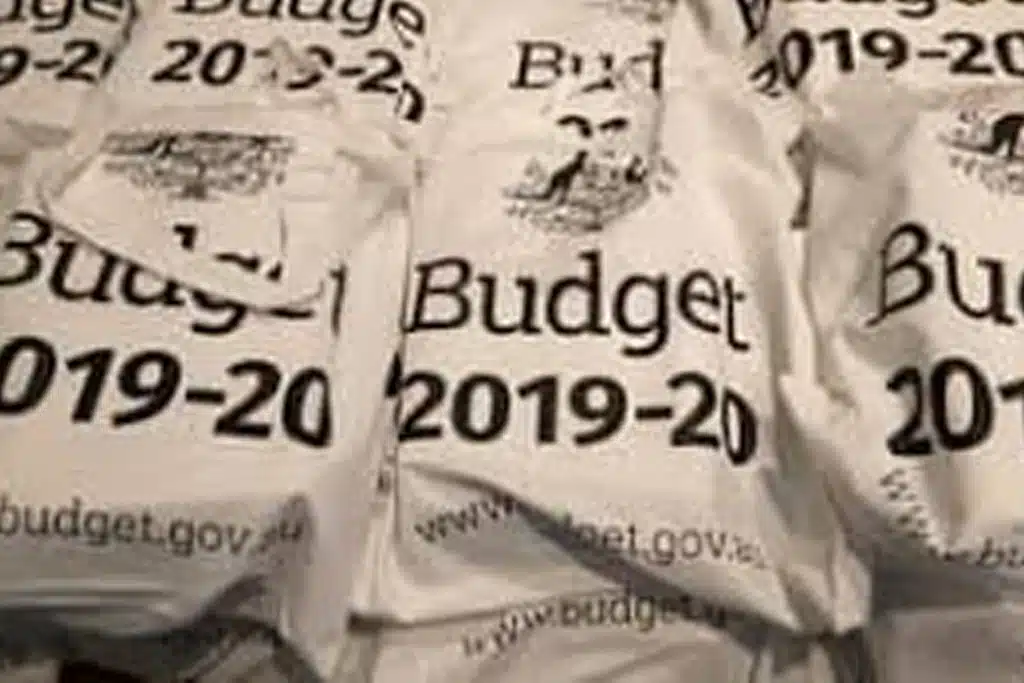Federal Budget 2019
Federal Budget Roundup 2019-20
On Tuesday, 2 April 2019, Treasurer Josh Frydenberg handed down the 2019-20 Federal Budget. Among the proposed changes were personal income tax cuts and changes to super rules. All measures of course, are reliant on the relevant legislation passing Parliament. Here is a summary of the key changes.
Individuals
Personal income tax cuts
As anticipated, the Budget celebrated the surplus with a $19.5bn package of personal income tax cuts for Australian residents. This package revises the legislated seven year income tax plan.
The personal tax changes mean a tax saving of $855 for someone on an annual taxable income of $45,000 per annum until 2022, then $1,080 until 2024 onwards.
| Tax thresholds | |||
|---|---|---|---|
| Tax rate | From 1 July 2018 | From 1 July 2022 | From 1 July 2024 |
| 0% | $0 - $18,200 | $0 - $18,200 | $0 - $18,200 |
| 19% | $18,201 - $37,000 | $18,201 - $45,000 | $18,201 - $45,000 |
| 30% | $45,001 - $200,000 | ||
| 32.5% | $37,001 - $90,000 | $45,001 - $120,000 | |
| 37% | $90,001 - $180,000 | $120,001 - $180,000 | - |
| 45% | >$180,000 | >$180,000 | >$200,000 |
| LMITO | Up to $1,080 | ||
| LITO | Up to $445 | Up to $700 | Up to $700 |
This round of tax cuts:
- Increases the top threshold of the 19% personal income tax bracket to $45,000 from 1 July 2022
- Reduces the 32.5% marginal tax rate to 30% from 1 July 2024-25
Low and middle income tax offset (LMITO) increased
| Date of effect | 2018-19 until 2021-22 |
|---|
The low and middle income tax offset (LMITO) will increase from a maximum amount of $530 to $1,080 per annum and the base amount will increase from $200 to $255 per annum.
The LMITO will provide a reduction in tax of up to $255 for taxpayers with a taxable income of $37,000 or less. Between taxable incomes of $37,000 and $48,000, the value of the offset will increase at a rate of 7.5 cents per dollar to the maximum offset of $1,080. Taxpayers with taxable incomes between $48,000 and $90,000 will be eligible for the maximum offset of $1,080. From taxable incomes of $90,000 to $126,000 the offset will phase out at a rate of 3 cents per dollar.
The LMITO is received after you have lodged your tax return.
Low income tax offset (LITO) increased
| Date of effect | 1 July 2022 |
|---|
From 1 July 2022, the Government will increase the low income tax offset (LITO) from $645 as legislated, to $700. The increased LITO will be withdrawn at a rate of 5 cents per dollar between taxable incomes of $37,500 and $45,000, instead of at 6.5 cents per dollar between taxable incomes of $37,000 and $41,000 as previously legislated under the plan. LITO will then be withdrawn at a rate of 1.5 cents per dollar between taxable incomes of $45,000 and $66,667.
Medicare levy thresholds increased
| Date of effect | 2018-19 |
|---|
The Medicare levy low income thresholds for singles, families, and seniors and pensioners will increase from the 2018-19 income year.
| Thresholds | Current | Proposed |
|---|---|---|
| Singles | $21,980 | $22,398 |
| Family | $37,089 | $37,794 |
| Single seniors and pensioners | $34,758 | $35,418 |
| Family seniors and pensioners | $48,385 | $49,304 |
| Dependent child or student | $3,406 | $3,471 |
More information
- Treasury Laws Amendment (Medicare Levy and Medicare Levy Surcharge) Bill 2019
Business
Instant asset write-off increased to $30k and expanded to businesses under $50m
| Date of effect | 7:30pm (AEDT) on 2 April 2019 to 30 June 2020 |
|---|
The threshold for the popular $20,000 instant asset write-off will increase to $30,000* from Budget night until 30 June 2020 when it will potentially return to its original $1,000 level on 1 July 2020. We say ‘potentially’ because the threshold has been at or above $20,000 since 12 May 2015.
The Government had previously announced an increase to the threshold for the instant asset write-off to $25,000 from 29 January 2019 but this measure was not legislated prior to the release of the Budget. The Government however intends to honour the announced rate increase.
In addition, the number of businesses that can access the instant asset write-off will increase. Currently, to qualify for the write-off, only businesses with an aggregated turnover under $10 million qualify. From Budget night, businesses with an aggregated turnover under $50 million will also be able to access the write-off.
| Instant asset write-off thresholds | Small Business* | Medium business** |
|---|---|---|
| 1 July 2019 – 28 January 2019 | $20,000 | - |
| 29 January – 2 April | $25,000 | - |
| 2 April - 30 June 2020 | $30,000 | $30,000 |
* aggregated turnover under $10 million
** aggregated turnover under $50 million
Assets will need to be used or installed ready for use from Budget night until by 30 June 2020 to qualify for the higher threshold. Anything previously purchased does not qualify for the higher rate but may qualify for the $20,000 or $25,000 threshold. Similarly, anything purchased but not installed ready for use by 30 June 2020 will not qualify.
The instant asset write-off only applies to certain depreciable assets. There are some assets, like horticultural plants, capital works (building construction costs etc.), assets leased to another party on a depreciating asset lease, etc., that don’t qualify.
For assets costing $30,000 or more
For small businesses (aggregated turnover under $10m), assets costing $30,000 or more can be allocated to a pool and depreciated at a rate of 15% in the first year and 30% for each year thereafter. If the closing balance of the pool, adjusted for current year depreciation deductions (i.e., these are added back), is less than $30,000 at the end of the income year, then the remaining pool balance can be written off as well.
The ‘lock out’ laws for the simplified depreciation rules (these prevent small businesses from re-entering the simplified depreciation regime for five years if they opt-out) will continue to be suspended until 30 June 2020.
Pooling is not available for medium sized businesses which means that the normal depreciation rules based on the effective life of the asset will apply to assets that don’t qualify for an immediate deduction.
This initiative is subject to the passage of legislation so don’t go out on a spending spree just yet!
* $30,000 exclusive of GST for GST registered businesses. $30,000 inclusive of GST for businesses not registered for GST.
Division 7A changes postponed
| Date of effect | 1 July 2020 |
|---|
Division 7A captures situations where shareholders access company profits in the form of loans, payments or the forgiveness of debts. The rules are drafted broadly and have become more complex as amendments close perceived loopholes.
Division 7A treats certain events as triggering “deemed” dividends for tax purposes. Where a private company makes a payment or loan to a shareholder or associate, the amount may be treated as a dividend for tax purposes. Where a debt owed by a shareholder or associate to a private company is forgiven, these amounts may be subject to the same treatment.
Significant changes to the way Division 7A works were intended start taking effect from 1 July 2019. These reforms have now been pushed back to 1 July 2020.
These proposed reforms include:
- While the current rules allow Division 7A loans to be placed under a 7 year or 25 year loan agreement, the new rules would only allow provide for a maximum 10 year loan agreement. Annual repayments of principal and interest would be required to prevent a deemed dividend from arising.
- Transitional rules would be introduced to ensure that all existing Division 7A loans are brought into the 10 year loan model. 7 year loans would retain their existing outstanding term. Existing 25 year loans would be largely exempt from the new rules until 30 June 2021.
- Loans made before 4 December 1997 that have not been forgiven (or deemed to have been forgiven) will be refreshed and brought within the scope of Division 7A. They will be treated as financial accommodation as at 30 June 2021 and will need to be repaid or placed under a complying loan agreement by the company’s lodgement day for the 2021 tax return to avoid a deemed dividend.
- The concept of distributable surplus will be completely removed, which means that the entire value of the loan, payment or forgiven debt will be an assessable deemed dividend regardless of the financial position of the company.
- Unpaid present entitlements (UPEs) will trigger a deemed dividend unless they are paid out or placed under a complying loan agreement by the lodgement day of the company’s tax return. Existing UPEs that arose between 16 December 2009 and 30 June 2019 will be brought within the scope of these new rules as well. Treasury is still considering whether UPEs that arose before 16 December 2009 should be brought within the scope of Division 7A.
- A self-correction mechanism will be introduced which will enable taxpayers to fix Division 7A problems without having to ask for the Commissioner’s discretion to disregard a deemed dividend. A number of conditions would need to be met in order to be able to take advantage of this (e.g., appropriate steps must be taken to fix the problem within 6 months of identifying the error).
- The amendment period rules for Division 7A issues will be extended to cover 14 years after the end of the income year in which the loan, payment or debt forgiveness occurred.
- Safe harbour mechanisms will be introduced in relation to the use of company assets where the parties are trying to show that the shareholder has paid an arm’s length amount for the use of the asset.
The postponement is a welcome move to provide more time for the measures. In some cases, there will be quite a bit of work to be done to implement the reforms.
Luxury car tax refunds increased for primary producers and tourism operators
| Date of effect | Vehicles acquired on or after 1 July 2019 |
|---|
For vehicles acquired on or after 1 July 2019, eligible primary producers and tourism operators will be able to apply for a refund of any luxury car tax paid, up to a maximum of $10,000.
Currently, primary producers and tourism operators may be eligible for a partial refund of the luxury car tax paid on eligible four wheel or all wheel drive cars, up to a maximum refund of $3,000. The eligibility criteria and types of vehicles eligible for the current partial refund will remain unchanged under the new refund arrangements.
ABN status stripped for non-compliance
| Date of effect | 1 July 2021, and 1 July 2022 |
|---|
From 1 July 2021, Australian Business Number (ABN) holders will be stripped of their ABNs if they fail to lodge their income tax return. In addition, from 1 July 2022, ABN holders will be required to annually confirm the accuracy of their details on the Australian Business Register.
Currently, ABN holders are able to retain their ABN regardless of whether they are meeting their income tax return lodgement obligations or the obligation to update their ABN details.
Support for small business in tax disputes
This previously announced measure provides $57m in funding over 5 years to provide access to a fast, low cost, independent review mechanism for small businesses in dispute with the ATO. The funding is directed to the Department of Jobs and Small Business, the Administrative Appeals Tribunal (AAT) and the Australian Taxation Office (ATO).
Increased funding for Export Market Development Scheme
$61m over three years has been provided to support Australian businesses to export Australian goods and services to overseas markets. $60m of the funding will go towards boosting reimbursement levels of eligible export marketing expenditure for small and medium enterprise exporters.
Superannuation
Superannuation ‘work test’ watered down & age limit for spouse contributions increased
| Date of effect | 1 July 2020 |
|---|
As previously announced, from 1 July 2020, Australians aged 65 and 66 will be able to make voluntary superannuation contributions (concessional and non-concessional) without meeting the Work Test. Currently, voluntary contributions can only be made if the individual has worked a minimum of 40 hours over a 30 day period (Work Test). Those aged 65 and 66 will also be able to make up to three years of non-concessional contributions under the bring-forward rule.
In addition, the age limit for spouse contributions will be increased from 69 to 74 years. Currently, those aged 70 years and over cannot receive
Extension of bring-forward contribution eligibility
In addition to the work test exemption, the Government has stated it would also permit “bring-forward” contributions for individuals aged 65 and 66. The ability to bring forward contributions is not currently available once an individual has reached age 65.
On a practical level, the measure would extend access to bring-forward contributions for an additional two years of an individual’s life. Bring-forward contributions allow individuals to use three years of non-concessional contributions in any one year – i.e. non-concessional contributions of up to $300,000 could be made in one financial year, significantly boosting superannuation fund assets available for investment.
The measure complements the work test exemption changes and is also stated to apply from 1 July 2020.
Permanent tax relief for merging super funds
The current tax relief for merging superannuation funds is due to expire on 1 July 2020. The Government will extend this measure permanently.
The tax relief, which enables superannuation funds to transfer revenue and capital losses to a new merged fund, and to defer taxation consequences on gains and losses from revenue and capital assets, has been available since December 2008.
Opt-in insurance delay
The Government will delay until 1 October 2019, the start date for reforms that ensure insurance within superannuation is only offered on an optin basis for accounts with balances of less than $6,000 and new accounts belonging to members under the age of 25 years.
Book in your End of Financial Year Meeting with us Today!
This is just a general summary of how the Budget may affect you. If you haven’t met with us yet, now is the time to contact us to arrange an End of Financial Year meeting, so we can help you limit your tax payments, discuss your goals and plans for the next year, and grow your wealth. Remember, we both need time to implement any appropriate tax savings strategies for you well before 30 June 2019.




